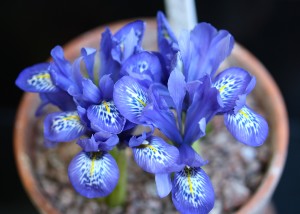I am a student of gardening history, especially in the winter, when actual gardening activities are necessarily limited. Sometimes in my reading, catalog perusal and other armchair activities, certain tantalizing figures pop up repeatedly. This happened recently with Lady Beatrix Stanley, whom I found waltzing across the pages of a snowdrop catalog, dancing through listings for a pottery company and mentioned repeatedly by vendors of dwarf irises.
Lady Beatrix—1877-1944–was an aristocrat, the daughter of a marquis and the wife of an earl’s younger son who was later knighted for his service to the government. She was also a great plantswoman, well known in the English horticultural circles of her time.
As is often the case with women in garden history, Lady Beatrix is something of a shadow. Finding her birth and death dates takes some doing, and the only pictures I could find were of her namesake iris and snowdrop. There is no Wikipedia listing for her, so I had to glean basic information from biographical sources about her husband, Lord George Stanley. Details about Lady Beatrix were spread over a plethora of plant websites and catalogs.
Beatrix Taylour married George Frederick Stanley in 1903, when she was the ripe old age of 26, and embarked on a career largely devoted to supporting her husband, who was, at various times, a Member of Parliament and a British colonial civil servant. The Stanleys were prominent social figures and Beatrix and her infant daughter starred on the cover of Country Life magazine in July 1907. But perhaps the biggest adventure of their married life occurred later, from 1929-1934, when Stanley served, first as Governor of Madras, now Chennai, in the Indian state of Tamil Nadu, and for one year as Acting Viceroy of India.
During the Stanleys’ time in India, Beatrix made gardens around the Governor’s residence in what was then called Ootacamund. She studied the native plants of various Indian regions, including Kashmir, and documented her experiences in writing and plant portraits, forwarding some of her drawings to the Royal Horticultural Society in London. . Her written output included an article, “Gardening in India”, published in the May 23, 1931 edition of the British publication, The Gardener’s Chronicle.
When not gardening, writing or painting, she also fostered community relations by founding the Nilgiri Ladies’ Club to facilitate interaction between Indian and English women. Lady Stanley’s gardening horizons changed when her husband’s colonial service ended and the couple returned to England. Her social status and horticultural expertise led to her being named editor of an RHS publication, The New Flora and Fauna, from 1938-1940.
Beatrix Stanley’s specialty was bulbous plants, especially snowdrops, which she grew at her home, Sibbertoft Manor. She made many friends among England’s galanthophiles. Among them was the renowned Edwardian gardener, E.A. Bowles, whose book My Garden in Fall and Winter, is still a classic. She and her friends propagated, cultivated and swapped plants, some of which are still on the market today, hence Beatrix’s appearance in my 2019 snowdrop catalog. A lovely double snowdrop was named after her. Another named plant, Iris histrioides ‘Lady Beatrix Stanley’, is a spring-flowering dwarf species with bright blue petals. This year, Moorcroft Pottery, a prestigious English manufacturer and vendor, introduced a vase and a jar inspired by Beatrix and depicting that same iris. I would buy one if it weren’t so pricey. As it is, I will have to content myself with a cache of the little plants in the front of one of my garden beds.
Beatrix Stanley also lives on in the snowdrops at Hodsock Priory, the historic house owned by her grandson, Andrew Buchanan. Every year, the Hodsock gardens open in spring to show off the amazing drifts of the little white flowers.
For a brief moment in time Beatrix dances on a white carpet and emerges into the public consciousness once again.
